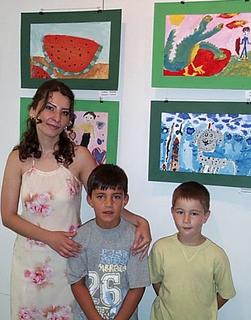hye life
Tuesday, July 26, 2005
Thursday, July 14, 2005
Saturday, July 02, 2005

First Strawbale Cool Storage in Armenia
Paul Sommers, USDA MAP Marketing Advisor, invited Daniel Retz, an engineer and a Peace Corps volunteer, to build a straw bale building for cool storage in Jrahovit village funded by MAP. The local cooperative members helped Mr. Retz in construction. According to him, straw bale buildings, widely used in the West US and in many other countries, insolate the storage space far better than stone buildings. In addition, it is cheaper, faster, and easier to build. "This is a special application and can be suitable for both cool storages and for houses," said Daniel. The idea is to use this storage as a model. There are already people and projects interested in using this method for building social buildings and houses. As stated by Daniel, straw bale storages will also allow reducing air pollution: it can become a value added product for farmers when sold as building material rather than burning the straw as a waste product. Daniel Retz and the cooperative members learned by doing. Their experience can be used for other straw bail constructions. Jrahovit fruit grower cooperative will own and maintain this cool storage. A compressor, evaporators, condenser, piping, and other necessary equipment have been installed. Very soon the members of the cooperative will start storing their fruits and vegetables in this unique straw bale cool storage, which is the first and the only one in Armenia. Paul Sommers made noticeable efforts to make this project happen. Vachik Grigoryan, assistant-translator and Levon Yeritsyan, driver, also provided valuable help.

October 2004 Homemade Vinegar Proves Effective in Controlling Weeds
Two groups of fresh herb growers recently participated in an experiment that has profound implications for improving crop management. They sprayed their own commonly made household vinegar (acidic acid) on weeds in their plots of tarragon and within one hour saw dramatic results: the weeds that they normally must remove by hand hoeing every 10 days were rapidly dying. "The results are simply dramatic" was the reaction of Alvard Tovmasyan and the 10 women of Nalbandian Village who witnessed the demonstration. The participants in Mrgashat Village echoed the same reaction. Four concentrations of vinegar were demonstrated: 6%, 10 %, 15%, and 20%. Dr. Sergey Yeritsyan of the AAA carefully prepared them. Growers under the supervision of Dr. Hrant Terlemezyan did the actual spraying. Nuneh Sarukhanyan of Agrogitaspir served as extension leader for the project. According to Sarukhanyan, the random plot findings showed that vinegar concentrations of 15% and 20% had the most immediate effect on weeds. However spray drift caused slight damage to the tarragon. The 10% and homemade 6% concentrated vinegar worked slower and also proved effective however they caused no damage to the tarragon crop. The idea for the demonstration came from Paul Sommers and Felix Vardarian of USDA MAP. "The idea was to validate research conducted by the USDA National Research Center at Beltsville under Armenian conditions," said Mr. Sommers." Vinegar is bio-safe, low cost, and is traditionally made by farm families. This successful exercise has great implications for reducing one of the most labor demanding and costly aspects of growing quality crops-weeds.

Ricotta Cheese Introduced to Domestic Market A New First for Armenia
The story of Ricotta cheese, started with the young son of USDA MAP TDY, Paul Sommers. In asking mom to bake lasagna (Italian dish made with ricotta cheese) he triggered a chain of events, which has resulted in sales of this new MAP-developed cheese to top Italian restaurants in Yerevan. "When I asked MAP TDY Cheese Specialist Poul Hansen about the availability of locally produced ricotta, his reaction was sure it can be made locally," said Mr. Sommers. Ricotta is a by-product of the cheese making process. "Before I would remove the whey from the mozzarella and discard it. MAP has provided me with a low cost process of converting the waste stream of whey into a new product that is in-demand and profitable," said Myasnik Grigoryan, the owner of Balaki Lechak plant. MAP marketing team investigated retail sources of imported ricotta and contacted restaurants to identify their needs for it. Hansen began to work with a goat cheese producer in Vatoz Dzor to demonstrate how to make ricotta. Marketing investigations showed that ricotta was imported (on an infrequent basis) from Italy and sold at a retail price of 3,500 drams for 250 grams. Its shelf life was also very limited. The marketing team also learned that Italian restaurants were very keen to have a supply of good quality locally produced ricotta for hot pasta dishes and desserts. Ricotta is now produced and marketed by Balak Cheese. Myasnik Grigoryan, the owner says that he cannot meet the demand for ricotta. Also the combination of producing mozzarella and ricotta has meant the several fold increase in profits. "This quick action, high impact exercise has increased the efficiency of the Balak's operation, expanded markets, increased sales and profits," added Mr. Sommers.













